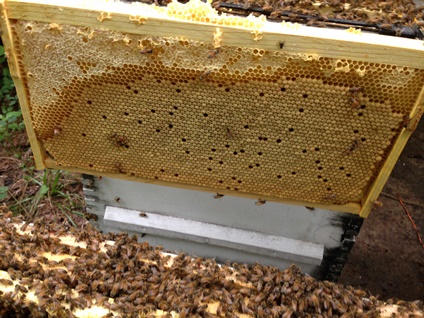Post Harvest Inspection
This weekend we checked the colonies at my house to make sure they're still doing well and have started cleaning up and repairing the honey super frames that we gave back to them after the honey harvest.

We found that the bees are finding and bringing in more honey.
We don't expect them to bring in very much right now, as we're on the verge of hot, dry summer heat which will cause the nectar to dry up.
What we did find, though, was the colony that had the most amount of supers on it was now queen-less (again). It hasn't had a permanent queen since sometime around May. We've given it frames of eggs, and they've made emergency queens. A few weeks would go by, but no laying queen. We'd introduce a queen via queen cage. Several days would go by, they would release her, she would lay about one frame of eggs and then disappear (or was murdered). I'd give them another frame of eggs, they'd make an emergency queen, but again, no viable laying queen.
Today, we double checked and again saw no sign of a queen in the colony. The colony's size is starting to shrink. By normal standards the colony is still holding 15+ frames of bees, but they won't be for much longer with no brood being raised to replace the aging bees who are dying off.
We found the newly mated and laying queen from one of the nucs I've been keeping on hand and introduced her into the colony via push-in-queen-cage method.
Below is a video I made a few years ago about how push in queen cages work.
In the push in queen cage we used today, we cut out a notch and pushed in a large marshmallow. When the bees in the colony have accepted the new queen, they will eat the marshmallow and free the caged queen.
We put the queen into the cage, slid the frame back into the colony and closed them up.
Since it hadn't started raining yet,we then looked at the second nuc that I've been keeping. They are doing great. So well in fact, that they are in need of being put into a larger colony, sold or reduced.

We took three frames containing wall-to-wall brood from the nuc and gave them to the dwindling colony and replaced them with 3 empty frames from the dwindling colony. It provides 3 frames of brood to a colony who could use the boost and gives the nuc queen room to lay more brood.
We'll check them in a week and see if they've released the queen, or if there was mutiny in the colony (again).
Comments For This Post: (4) | Post Your Comments! Hide The Comment Form